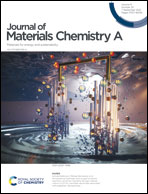Electrochemical formation and dissolution of an iodine–halide coordination solid complex in a nano-confined space†
Abstract
Iodide and iodine comprise a promising redox couple in aqueous energy storage systems (aqua-ESSs). However, the corresponding half-redox reaction on the cathode of an aqua-ESS has most often been considered as simply I2 (or I3−)/I−. Here, we describe for the first time reversible electrochemical formation and dissolution of insoluble iodine–halide coordination networks, [(I2)n·X−] (X− = Br− and I−), in confined nanopores with microporous carbon (micro-C) serving as a positive electrode in an aqua-ESS and using I− as the redox active electrolyte during charging. In an electrochemical cell without added Br−, the main half-redox reaction changed from I2/I− to [(I2)n·I−]/I− (n = 1 and 2) as charging and discharging accelerated (i.e., as current densities increased). When Br− was added to the electrolyte with I−, [(I2)n·Br−] was formed by electro-oxidation of I−, which was stably encapsulated in nanopores of micro-C regardless of the charging/discharging rate. Our findings suggest that [(I2)n·Br−]/I− half-redox reactions can produce superior energy and power densities in an aqua-ESS with porous carbon electrodes through the addition of Br− to their electrolytes compared with electrodes with I− only.



 Please wait while we load your content...
Please wait while we load your content...